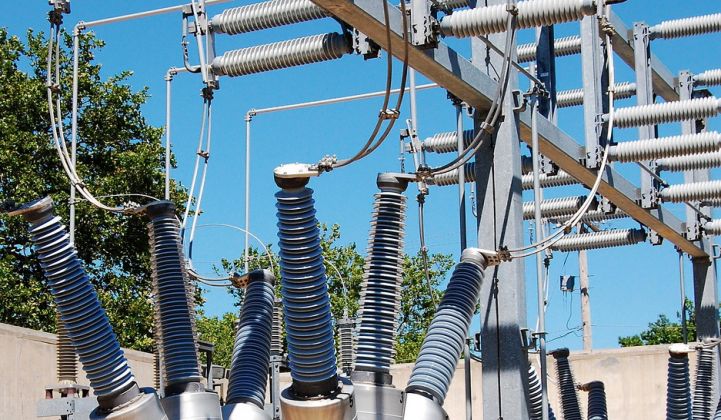Cisco wants to do for the smart grid what it’s done for the internet in terms of networking -- but it’s not claiming to be an expert in smart meters, substations, transmission lines or other live grid gear. It’s relying on partners for that, like U.S. smart meter maker Itron, or now, French power grid giant Alstom.
On Tuesday, Cisco announced a new partnership with Alstom to integrate its end-to-end IP network, running over its grid-hardened routers and switches, with Alstom’s hard grid assets like power switches, protective relays, capacitors, voltage regulators and the digital control systems that keep them all running.
Products have been in testing starting this month, and Alstom may soon announce pilot projects using the integrated technology, said Michael Dulaney, director of business development for Cisco’s Connected Energy business.
In addition, Cisco is looking at launching new substation products beyond its core routers and switches, which have been on the market since 2010, he said, though he wouldn’t provide details.
So what’s new here? Cisco has already done substation projects for customers such as Ausgrid, Duke Energy and First Wind, to name a few of its more than 100 utility and energy customers. Likewise, various vendor partners are using Cisco's system to manage the transition from serial SCADA communications protocols to true IP-enabled smart grid communications.
But the Alstom integration is a bit closer than Cisco’s work with other substation vendors so far, Dulaney said. As a “solutions technology integrator” partner, Alstom is embedding Cisco’s IPv6-capable platform in its substation gear, much like other STI partners Johnson Controls and Schneider Electric have built Cisco’s EnergyWise building energy management technology into their building automation systems.
On the smart grid front, Cisco has a similar partnership with Cooper Power Systems, the maker of grid gear bought by Eaton in May. But its longest smart grid relationship thus far has been with Itron, which has built Cisco’s field area network capabilities into the smart meters it’s now installing at commercial scale for Canadian utilities BC Hydro and Fortis BC, as well as in pilot scale with New England utility National Grid.
Cisco and Alstom aren’t the only grid players promising IP to replace the serial communications that now dominate the substation space. One term of art for this is Internet Protocol/Multi-Protocol Label Switching (IP/MPLS) technology, which seeks to carry IP-based communications as far into the substation as possible, and then switch it over to protocols like DNP-3, Modbus, IEC 60870-104 and, most recently, IEC 61850 -- usually as close to the endpoint devices as possible.
That means that many different carriers, from cellular providers like Verizon, AT&T, Sprint, etc. to private utility networks from the likes of Alcatel-Lucent, Motorola, Freewave, et al., are tunneling IP networks between control centers and substation gear from a variety of vendors. In fact, standardization is a critical way to unlock the proprietary maze of technologies that now dominate the space, Dulaney noted.
Beyond breaking down those proprietary silos, however, an end-to-end IP network may be a critical way to overcome the morass of cybersecurity issues plaguing smart grid vendors trying to bring their last-generation SCADA and grid control gear up to the new standards of the smart grid, Dulaney said.
“Utilities are under enormous pressure from [federal regulators] FERC and NIST to get up to speed and get the latest in security out there,” he said. “The best way to resolve the vulnerabilities is to get things on a standard. […] Utilities are not paid to take technology risk, nor should they be asked to.”
Instead, when it comes to its new smart grid efforts, “Cisco takes the technology risk,” using some of the same tools that now secure Wall Street stock-trading and other such high-security, always-on networking tasks over IP, he said.
Of course, Cisco has to let go of its IP-grade security at the end points where it translates to various legacy protocols -- the multi-protocol part of the MPLS equation. To manage the low-latency, high-complexity tasks that substations need to perform to keep electric power in control, Cisco’s general plan is to embed as much distributed intelligence as deep into the network “as is technically and economically feasible,” he said, and then encrypt and otherwise secure the IP traffic throughout the majority of the exchange.
In the big picture, Cisco has a wide range of smart grid initiatives underway, ranging from tight integration like its Itron and Alstom work to overarching network architecture and smart grid planning lines of business. At the same time, lots of other substation and distribution grid automation players are no doubt working up their own versions of bringing IP down into the substation, working with various partners to do so.
Cisco’s a leader in the space -- but it’s not the only one. In the hardened grid router category, the market leader is RuggedCom, a Canadian company bought by Siemens for $381 million this year, while Juniper and Alcatel-Lucent also do some utility business, including grid communications. Swiss grid giant ABB bought Tropos Networks, maker of a beefed-up municipal and utility Wi-Fi technology that can take on IP-enabled tasks. U.S. smart meter networking startup Silver Spring Networks says its system is built on IP, and is getting into distribution automation as well as meter reading. Let's face it, IP is the future for the smart grid. The only question is which companies get us there.



